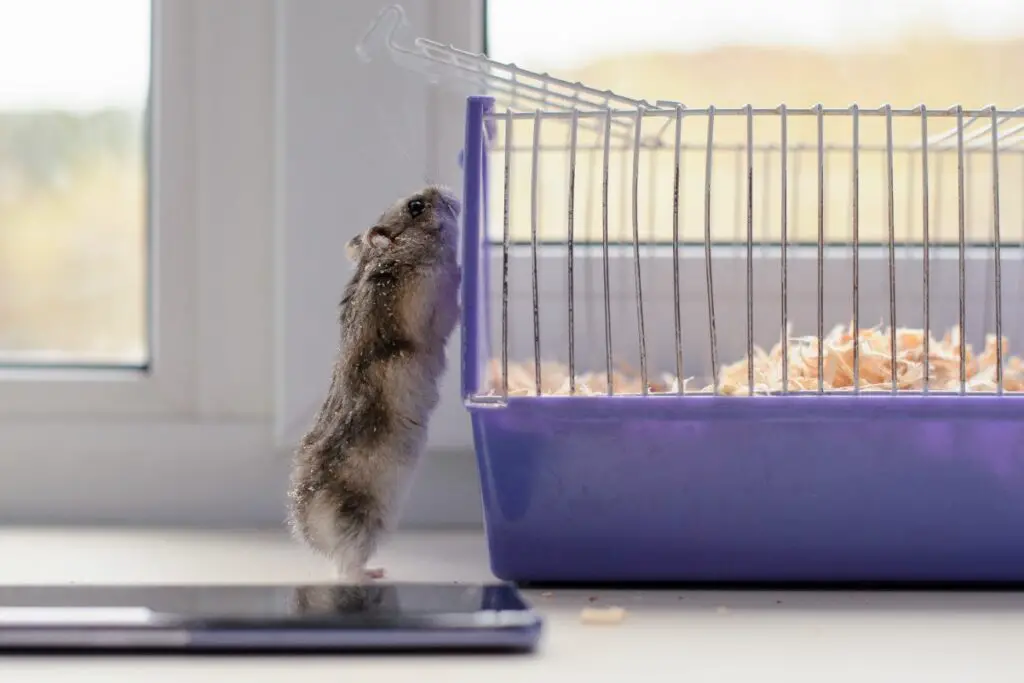Hamsters are known for their energetic and curious nature, which can sometimes lead to them trying to escape from their cages.
As someone who’s owned hamsters my entire life, I have seen many cases where hamsters have managed or at least tried to escape their enclosures. This can be a stressful situation.
In this blog post, we will explore the reasons behind hamsters trying to escape and the steps you can take to prevent it from happening.
What behavior is considered as “trying to escape”?
Hamsters may exhibit various behaviors when trying to escape, including climbing the cage walls, chewing the cage bars, and digging in the corners of the cage.
They may also try to squeeze through small openings or gnaw through the cage wires to break free. It is essential to understand that these behaviors are not just signs of boredom or restlessness but can indicate underlying issues that need to be addressed.
Is it normal for hamsters to try to escape?
While it is common for hamsters to exhibit some escape-seeking behavior, it is not considered normal or healthy.
Hamsters that are content and well-adjusted in their environment are less likely to try to escape. Therefore, if your hamster is consistently trying to break free, it may be an indication that something is not right with their living conditions or health.

Reasons for Hamsters Trying to Escape
Inadequate living conditions
Hamsters are active animals that require enough space to move around and explore. If their cage is too small or cramped, it can cause them to feel stressed, anxious, or frustrated, leading to escape attempts.
Also, if the cage lacks essential features like a wheel, tunnels, or toys, hamsters may become bored and try to escape to seek stimulation.
Not enough exercise and stimulation
Hamsters are natural burrowers and climbers that require daily exercise and mental stimulation to stay healthy and happy.
If your hamster is not getting enough exercise or lacks adequate enrichment in their cage, they may become restless and try to escape.
Feeling threatened or scared
Hamsters are prey animals that can easily become frightened by loud noises, sudden movements, or unfamiliar scents.
If they feel threatened or unsafe in their environment, they may try to escape to find a safer place.
Illness or discomfort
If your hamster is sick or in pain, they may try to escape to seek relief or avoid further discomfort. For example, if they have a urinary tract infection or diarrhea, they may try to escape to avoid soiling their bedding.
How to Prevent Hamsters from Escaping
Choosing the right cage and accessories
To prevent your hamster from trying to escape, you need to provide them with a comfortable and spacious cage that meets their needs. Look for a cage that is at least 450 square inches in size, with vertical space for climbing, and horizontal space for running.
Also, choose accessories like a wheel, hammocks, tunnels, and chew toys to keep your hamster mentally stimulated and physically active.
Creating an enriching environment
In addition to choosing the right cage and accessories, you can also create an enriching environment for your hamster by adding bedding materials like shredded paper, hay, or wood shavings.
You can also provide them with fresh veggies, fruits, or seeds to forage on, which will keep them occupied and satisfied.
Bonding with your hamster
Hamsters are social animals that enjoy human interaction and affection. Spending time with your hamster and bonding with them through gentle handling and playtime can help reduce their stress levels and prevent escape attempts.
Regular health check-ups and care
Regular health check-ups and care are essential to ensure that your hamster remains healthy and disease-free. Schedule regular visits with your veterinarian to check for any signs of illness or discomfort and get timely treatment if needed.
What to Do if Your Hamster Escapes
Searching for your hamster
If your hamster has managed to escape, the first thing you should do is search for them in the immediate vicinity of their cage. Look for them under furniture, inside cupboards, or behind curtains. Hamsters are excellent at hiding, so be patient and thorough in your search.
Setting traps and baiting
If your hamster is still missing, you can set up traps and bait to lure them back. Place their favorite food or treats in a small box or container and leave it out in the open.
You can also set up a humane trap that will catch your hamster without harming them.
Prevent future escapes
Once you have found your hamster, it is essential to take steps to prevent future escapes. Address any underlying issues that may have caused your hamster to try to escape and make necessary adjustments to their living conditions or care. Also, make sure that their cage is secure and that there are no openings or gaps that they can exploit.
Conclusion
In summary, hamsters may try to escape due to inadequate living conditions, lack of exercise and stimulation, feeling threatened, or illness. To prevent escape attempts, you can choose the right cage and accessories, create an enriching environment, bond with your hamster, and provide regular health care. If your hamster does manage to escape, search for them, set traps and bait, and take measures to prevent future escapes.
I encourage all hamster owners to understand their pets’ needs and provide them with the best possible care. Hamsters are delightful pets that can bring so much joy and companionship to our lives, and it is our responsibility to ensure they are happy, healthy, and safe. With the right care and attention, your hamster will thrive and never feel the need to escape.
- How Long Do American Eskimo Dogs Live? Important Factors and Care Tips - September 29, 2023
- Do American Bulldogs Need Grooming? Essential Tips and Care Guidelines - September 29, 2023
- Do Bengal Cats Enjoy Playing? Essential Tips for Keeping Them Active - September 29, 2023